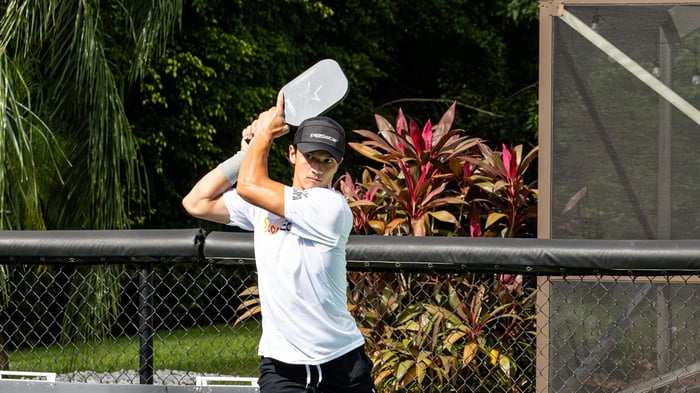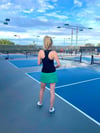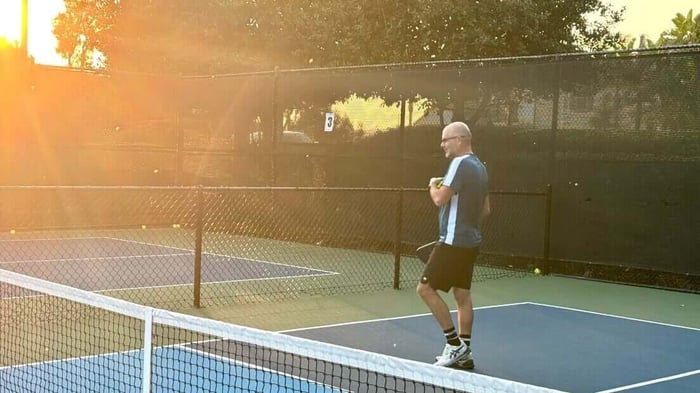Key takeaways:
Mastering spin in pickleball can significantly enhance your game by giving you better control over ball trajectory, speed, and bounce.
Honing your spin techniques, such as topspin and backspin, requires practice, precision, and equipment like PB5star paddles and shoes.
The paddle’s surface offers friction and control that can influence spin depending on technique.
Adding spin to your pickleball game is a true game-changer. It’s one of those skills that separates casual hitters from players who can control a match's pace and direction. Whether it’s a dipping topspin drive or a skidding backspin return, spin adds unpredictability and sharpens your ability to dictate play from anywhere on the court. It becomes a reliable tool for keeping your opponents on the defensive and creating more opportunities to win points.
Spin doesn’t just make your shots look impressive; it gives you a competitive edge. With the right technique, you can add shape, strategy, and precision to every rally. It allows you to shift from reacting to leading the game, forcing errors, and keeping your opponents guessing. At PB5star, we offer high-quality paddles and performance apparel to help you play sharper, move smarter, and bring your best spin game to life.
Understanding Pickleball Spin: Basic Techniques
Adding spin to your shots is one of the most effective ways to gain control and outmaneuver your opponents in pickleball. While it might seem advanced at first, learning the basic types of spin, like topspin, backspin, and even flat shots, can quickly improve your placement, pace, and consistency. Understanding how each spin works and when to use it lays the groundwork for more imaginative, more strategic play.
Topspin
What is it?: A forward-spinning shot that causes the ball to dip quickly and bounce higher on your opponent’s side.
How to do it: Brush up on the back of the ball with a low-to-high paddle motion, keeping your wrist relaxed and your follow-through smooth.
When to use it: Great for drives and passing shots, a topspin lets you hit harder while keeping the ball in play, especially when attacking from the baseline.
Backspin (slice)
What is it?: A backward-spinning shot that floats and stays low, often used to slow down play.
How to do it: Use a high-to-low paddle motion, slicing underneath the ball with a slightly open paddle face.
When to use it: Effective for dinks, drop shots, and returns that force your opponent to hit upward and lose pace.
Flat shot
What is it?: A neutral shot with minimal spin, offering consistent, straight flight.
How to do it: Hit through the center of the ball with a level paddle face and minimal wrist movement.
When to use it: It is helpful for high-percentage shots or when setting up your next spin-heavy play; it keeps things simple and steady.
As you get more comfortable with these foundational spins, you’ll notice how minor adjustments can completely change a rally. Developing reliable spin control early on builds the confidence to explore more advanced techniques later. With regular practice and attention to how each shot feels, spin becomes less of a trick and more of a trusted tool in your overall game strategy.
Advanced pickleball spin techniques and how to practice them
Once you’ve mastered the basics, adding more advanced spin techniques can unlock a new level of control and creativity on the court. These spins aren’t just about flash; they can break patterns, force errors, and open up opportunities that flat shots simply can’t. The key is learning to apply them with purpose and precision, not just power.
Side spin
What is it?: A spin that causes the ball to curve sideways in flight and skid on the bounce, making it harder for opponents to predict or return.
How to do it: Swing across the ball from left to right (or vice versa), using a slightly open or closed paddle face, depending on your dominant hand.
When to use it: Ideal for cross-court dinks, sharp angles, and pulling opponents out of position. It’s especially effective when changing direction.
Hybrid spin (topspin + sidespin)
What is it?: A combination spin that dips and curves mid-air, making it especially difficult to read and return.
How to do it: Brush up and across the ball in a diagonal motion, blending the upward motion of topspin with the lateral movement of sidespin.
When to use it: Great for attacking from mid-court or to force a weak return. It works well on aggressive dinks, topspin drops, or wide passing shots.
Deceptive spin shots
What is it?: Spin disguised with minimal change in body or paddle position, tricking your opponent into misreading the ball’s behavior.
How to do it: Use a similar setup for different spins, then slightly adjust your wrist or paddle angle at the last moment to apply unexpected spin.
When to use it: It is best used during rallies when your opponent anticipates a familiar shot. A well-timed deceptive spin can force errors or set up a winning follow-up.
Speed + spin combinations
What is it?: Applying spin at higher speeds, especially on drives and serves, to overwhelm your opponent with movement and pace.
How to do it: Add more paddle speed and body rotation while maintaining your spin mechanics. This requires balance and timing.
When to use it: Perfect for third-shot drives, deep returns, or aggressive serves. Thanks to the added spin, these shots can push your opponent back and limit their reaction time.
Refining advanced spin takes time, but your game's payoff is versatility and unpredictability. With regular, focused practice, these techniques become tools you can trust in high-pressure moments. Whether placing sharp angles or throwing off your opponent's timing, spin gives you the edge to shape every rally on your terms.
Practicing spin with purpose: drills and game scenarios
Learning spin is one thing, owning it in live play is another. Purposeful practice helps you develop muscle memory, improve shot consistency, and understand how spin can shape the flow of a game. These simple drills focus on technique, control, and real-world application so you can confidently bring your spin into match play and tournaments.
Topspin wall drill: Stand a few feet from a solid wall and hit controlled topspin forehands using a low-to-high paddle motion. Focus on making the ball dip quickly and rebound upward.
Backspin target drops: Use cones or markers to create target zones near the net. Practice slicing soft drop shots that land and stay low, which is ideal for neutralizing faster rallies.
Crosscourt sidespin challenge: Rally with a partner using only crosscourt shots with sidespin. Watch how the ball curves and adjust footwork and timing accordingly.
Hybrid spin-dink drill: Practice short dinks while brushing up and across the ball to combine topspin and sidespin. This is great for creating awkward bounces and keeping opponents off balance.
Bringing spin into your competitive game is all about timing and intention. Use topspin for aggressive drives, backspin to reset tempo, and hybrid or sidespin to create angles and disrupt rhythm. Practicing with purpose helps you spot opportunities in real time and apply spin where it counts most.
Common spin mistakes and how to fix them
Adding spin to your game can be exciting, but like any new skill, it has a learning curve. Many players, especially those just getting comfortable with spin, encounter common challenges that can hold them back or lead to frustration. Recognizing these mistakes early on is the first step toward fixing them and turning spin into a consistent, confident part of your strategy.
Overusing spin on every shot
The mistake: Relying on spin too often can lead to inconsistency and missed opportunities for simple, effective shots.
The fix: Use spin strategically, mix it with neutral or flat shots to stay unpredictable and maintain control.
Incorrect paddle angle at contact
The mistake: A paddle that is too open or closed can cause pop-ups or missed shots.
The fix: Focus on clean, deliberate contact with a consistent paddle face angle, and practice slow-motion swings to build muscle memory.
Forcing spin with too much wrist
The mistake: Over-snapping the wrist can reduce control and increase the chance of mishits.
The fix: Let the entire arm and body support the motion. Use your wrist as a finishing touch, not the primary source of spin.
Ignoring footwork and body position
The mistake: Poor positioning can throw off timing, making it hard to apply spin correctly.
The fix: Stay light on your feet and prepare early. Proper spacing and balance help you execute spin techniques more reliably.
Mastering spin isn’t about perfection; it’s about progress. You’ll gain more control, consistency, and confidence in every shot by identifying and correcting minor technical errors. Keep practicing with intention; over time, spin will become second nature, not just a tactic, but a trusted part of your overall game.
Frequently asked questions (FAQ) about Pickleball spin techniques
As players start working spin into their game, a few common questions arise, especially around technique, equipment, and when to use spin during play. This section offers simple, practical answers to help you feel more confident, whether just starting or fine-tuning your control.
Can pickleball beginners learn to use spin effectively?
Yes, absolutely. While spin can initially feel tricky, even beginners can start with simple topspin or backspin with minor paddle adjustments. The key is practicing slowly and focusing on clean contact before adding speed or complexity.
Do I need a special pickleball paddle to generate spin?
You don’t need a pro-level paddle, but the surface texture does make a difference. Paddles with a gritty or raw carbon surface tend to grip the ball better, which helps create more spin with less effort.
How can I tell if my pickleball opponent is using a spin technique?
Watch their paddle motion. An upward brush suggests topspin, while a slicing motion indicates backspin or sidespin. You can also observe how the ball behaves in the air and bounces. Spin often causes unusual curves or skids.
Mastering spin is a process, and having questions is normal. With the right mindset, consistent practice, and experimentation, you’ll feel more comfortable using spin as a natural part of your strategy. Keep exploring, stay curious, and let your game evolve one shot at a time.
Take your spin game to new heights
Mastering spin takes patience, but the payoff is absolute control, variety, and confidence in your game. You'll feel how spin can shape every rally as you experiment with different techniques, from simple topspin to advanced hybrid spins. With each practice session, you’ll better understand how to use spin for style and as a smart, strategic advantage.
The more intentional you are with your spin, the more unpredictable and effective your play becomes. Stay consistent, stay curious, and trust the process. Great spin takes time, but once it clicks, it can transform how you compete. PB5star’s performance paddles and apparel are built to support that journey, helping you spin smarter and play sharper every time you step on the court.







